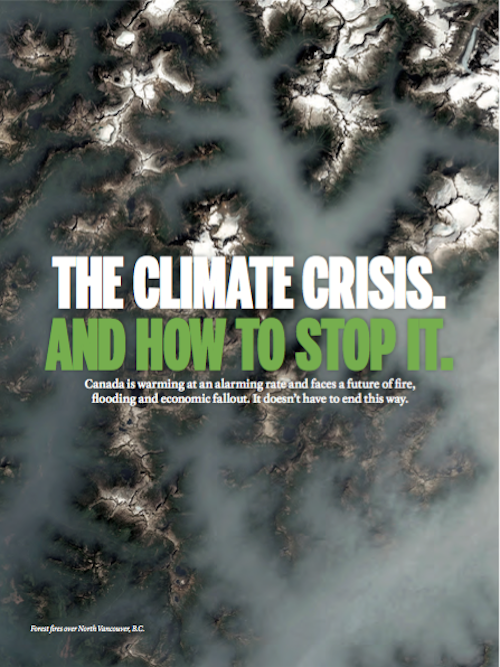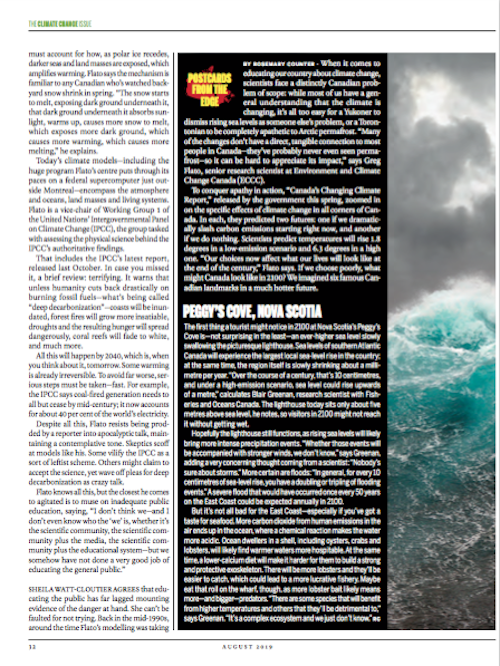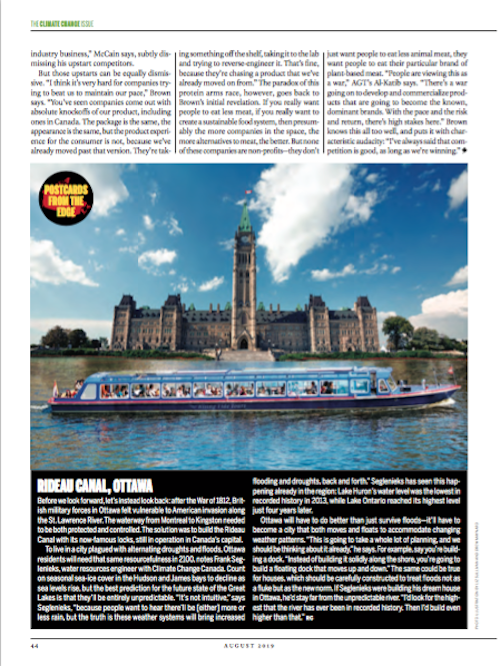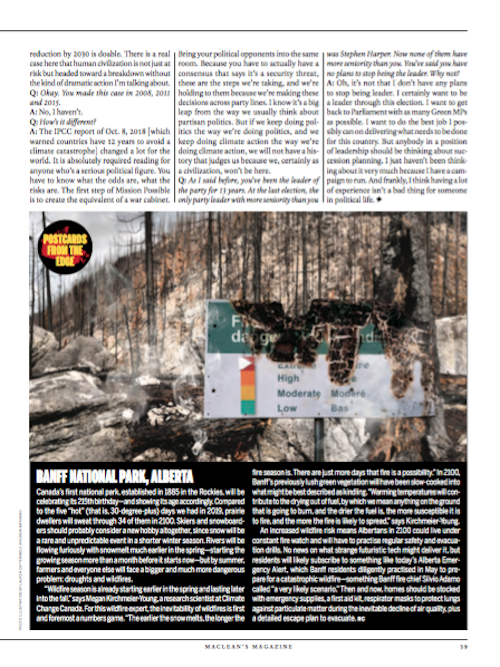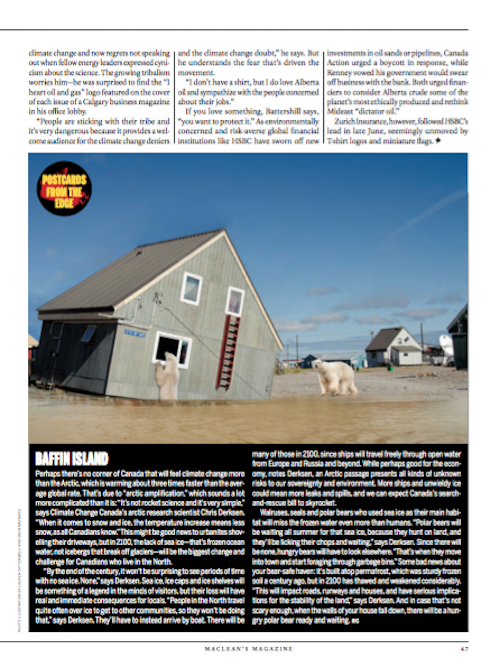Postcards from the Edge
Famous Canadian landmarks in a much hotter future
When it comes to educating our country about climate change, scientists face a distinctly Canadian problem of scope: While most of us have a general understanding that the climate is changing, it’s is all too easy for a Yukoner to dismiss rising sea levels as someone else’s problem or a Torontonian to be completely apathetic to Arctic permafrost. “Many of the changes don’t have a direct, tangible connection to most people in Canada—they’ve probably never even seen permafrost—so it can be hard to appreciate its impact,” says Greg Flato, senior research scientist at Environment and Climate Change Canada (ECCC).
To conquer apathy in action, Canada’s Changing Climate Report, released by the government this spring, zoomed in on the specific effects of climate change in all corners of Canada. In each, they predicted two futures: One if we dramatically slash carbon emissions starting right now, and another if we do nothing. Scientists predict temperatures will rise 1.8 degrees in a low-emission scenario and 6.3 degrees in a high one. “Our choices now effect what our lives will look like at the end of the century,” Flato says. If we choose poorly, what might Canada look like in 2100? We imagined six famous Canadian landmarks in a much hotter future.
Peggy’s Cove, Nova Scotia
The first thing a tourist might notice in 2100 at Nova Scotia’s Peggy’s Cove is—not surprising in the least—an ever higher sea level slowly swallowing the picturesque lighthouse. Sea levels of southern Atlantic Canada will experience the largest local sea-level rise in the country; at the same time, the region itself is slowly shrinking about a millimetre per year. “Over the course of a century, that’s 10 centimetres, and under a high emission scenario, sea level could rise upwards of a meter,” calculates Blair Greenan, research scientist with Fisheries and Oceans Canada. The lighthouse today sits only about 5 metres above sea level, he notes, so visitors in 2100 might not reach it without getting wet.
Hopefully the lighthouse still functions, as rising sea levels will likely bring more intense precipitation events. “Whether those events will be accompanied with stronger winds, we don’t know,” says Greenan, adding a very concerning thought coming from a scientist: “Nobody’s sure about storms.” More certain are floods: “In general, for every 10 centimetres of sea level rise, you have a doubling or tripling of flooding events.” A severe flood that would have occurred once every 50 years on the East Coast could be expected annually in 2100.
But it’s not all bad for the East Coast—especially if you’ve got a taste for seafood. More carbon dioxide from human emissions in the air ends up in the ocean, where a chemical reaction makes the water more acidic. Ocean dwellers in a shell, including oysters, crabs, scallops and lobsters, will likely find warmer waters more hospitable. At the same time, a lower-calcium diet will make it harder for them to build a strong and protective exoskeleton. There will be more lobsters and easier to catch, which could lead to a more lucrative fishery. Maybe eat that roll on the wharf, however, as more lobster bait likely means more—and bigger—predators. “There are some species that will benefit from higher temperatures and others that they’ll be detrimental to,” says Greenan. “It’s a complex ecosystem and we just don’t know.”
Baffin Island
Perhaps there’s no corner of Canada that will feel climate change harder than the Arctic, which is warming about three times faster than the average global rate. That’s due to “arctic amplification,” which sounds a lot more complicated than it is: “It’s not rocket science and it’s very simple,” says ECCC’s arctic research scientist Chris Derksen. “When it comes to snow and ice, the temperature increase means less snow, as all Canadians know.” This might be good news to urbanites shovelling their driveways, but in 2100, the lack of sea ice—that’s frozen ocean water, not icebergs that break off glaciers—will be the biggest change and challenge for Canadians who live in the North.
“By the end of the century, it won’t be surprising to see periods of time with no sea ice. None,” says Derksen. Sea ice, ice caps and ice shelves will be something of legend in the minds of visitors, but their loss will have real and immediate consequences for locals. “People in the North travel quite often over ice to get to other communities, so they won’t be doing that,” says Derksen. They’ll have to instead arrive by boat. There will be many of those in 2100, since ships can travel freely through open water from Europe and Russia and beyond. While perhaps good for the economy, notes Derksen, an Arctic passage presents all kinds of unknown risks to our sovereignty and environment. More ships and unwieldy ice could mean more leaks and spills, and expect Canada’s search and rescue bill to skyrocket.
Walruses, seals and polar bears who used sea ice as their main habitat will miss the frozen water even more than humans. “Polar bears will be waiting all summer for that sea ice, because they hunt on land, and they’ll be licking their chops and waiting,” says Derksen. Since there is none, hungry bears will have to look elsewhere. “That’s when they move into town and start foraging through garbage bins and getting into homes.” But some bad news about your bear-safe haven: It’s built atop permafrost, which was sturdy frozen soil a century ago, but in 2100 has thawed and weakened considerably. “This will impact roads, runways and houses, and have serious implications for the stability of the land,” says Derksen. And in case that’s not scary enough, when the walls of your house fall down, there’s a hungry polar bear ready and waiting.
Rideau Canal, Ottawa
Before we look forward, let’s instead look back: After the War of 1812, British military forces in Ottawa felt vulnerable to American invasion along the St. Lawrence River. The waterway from Montreal to Kingston needed to be both protected and controlled. The solution was to build the Rideau Canal with its now-famous locks, still in operation in Canada’s capital.
To live in city plagued with alternating droughts and floods, Ottawa residents will need that same resourcefulness in 2100, notes Frank Seglenieks, water resources engineer with Climate Change Canada. Count on seasonal sea ice cover in Hudson and James Bays to decline as the sea level rises, but the best prediction for the future state of the Great Lakes is that they’ll be entirely unpredictable. “It’s not intuitive,” says Seglenieks, “because people want to hear they’ll be [either] more or less rain, but the truth is these weather systems will bring increased flooding and droughts, back and forth.” Seglenieks has seen this happening already in the region: Lake Huron’s water level was the lowest in recorded history in 2013, while Lake Ontario reached its highest level just four years later.
Ottawa will have to do better than just survive floods—it’ll have to become a city that both moves and floats to accommodate changing weather patterns. “This is going to take a whole lot of planning, and we should be thinking about it already,” he says. For example, say you’re building a dock. “Instead of building it solidly along the shore, you’re going to build a floating dock that moves up and down.” The same could be true for houses, which should be carefully constructed to treat floods not as fluke but as the new norm. If Seglenieks were building his dream house in Ottawa, he’d stay far from the unpredictable river. “I’d look for the highest that the river has ever been in recorded history. Then I’d build even higher than that.”
Banff National Park, Alberta
Canada’s first national park, established in 1885 in the Rockies, will be celebrating its 215th birthday—and showing its age accordingly. Compared to the 5 “hot” (that is, thirty degrees plus) days we had in 2019, prairie dwellers will sweat through 34 of them in 2100. Skiers and snowboarders should probably consider a new hobby altogether, since snow will be a rare and unpredictable event in a shorter winter season. Rivers will be flowing furiously with snowmelt much earlier in the spring—starting the growing season more than a month before it starts now—but by summer, farmers and everyone else will face a bigger and much more dangerous problem: droughts and wildfires.
“Wildfire season is already starting earlier in the spring and lasting later into the fall,” says Megan Kirchmeier-Young, a research scientist at ECCC. For this wildfire expert, the inevitability of wildfires is first and foremost a numbers game. “The earlier the snow melts, the longer the fire season is. There are just more days that fire is a possibility.” In 2100, Banff’s previously lush green vegetation will have been slow cooked into what might be best described as kindling. “Warming temperatures will contribute to the drying out of fuel, by which we mean anything on the ground that is going to burn, and the drier the fuel is, the more susceptible it is to fire and the more the fire is likely to spread,” says Kirchmeier-Young.
An increased wildfire risk means Albertans in 2100 could live under constant fire watch and will have to practice regular safety and evacuation drills. No news on what strange futuristic tech might deliver it, but residents will likely subscribe to something like today’s Alberta Emergency Alert, which Banff residents diligently practiced in May to prepare for a catastrophic wildfire that Banff fire chief Silvio Adamo called “a very likely scenario.” Then and now, homes should be stocked with emergency supplies, a first aid kit, respirator masks to protect the lungs against particulate matter during the inevitable decline of air quality, plus a detailed escape plan to evacuate.
The Okanagan Valley, British Columbia
In some places in the world, notes UBC Agriculture prof Sean Smukler, climate change could be actually be good. “British Columbia is one of those places,” he says, and, especially if you happen to be a farmer, the 5 degree temperature jump predicted for the West Coast might not be as bad as it seems. “By 2100, a lot of forest here could be grassland,” he says. Provided we develop the technology and stockpile the resources we’ll need, the interior of BC could be a lush green garden with long growing seasons and warmer temperatures that accommodate the exotic fruits and vegetables we can’t grow now.
“These days, much of our vegetables are shipped up from California,” says Smukler. “In the future, if we’re reliant on California’s ability to plan for climate change, we’ll sort of be at their mercy.” Recent years have proved that weather in the American south immediately affects Canadian shoppers—a cool period in California is the reason a bunch of celery now costs upwards of $5.99—but all that could be avoided in 2100. “If we’re smart and productive, we’ll take advantage of longer growing seasons, learn how to best manage our water, and take control of the pests that will inevitably start invading our crops.”
Yup, our tropical agricultural paradise of B.C.-grown oranges, avocados, pistachios or olives will bring with it some less appetizing realities of pests: alongside the usual offenders like rats and roaches, expect a new cohort of “organisms that impact our crops that we’ve seen before,” says Smukler. Whether weeds, insects or diseases, warmer weather is great news for many pests who would otherwise be controlled by a regular winter frost.
And what about wine? There likely will be vino to take the edge off. “Of all the producers out there, grape growers have a very high capacity to adapt,” explains Smukler. “Both because of the chemical constituency of the grapes themselves and because of the capital that growers have to prepare.”
Montreal, Quebec
With too many buildings crammed atop too much heat-absorbing pavement, dense cities like Montreal with too hot temperatures have the unfortunate fate of getting even hotter. An “urban heat island” is just as it sounds: Too many humans and human activity, not enough cool breeze or green space. Officially, Montreal currently counts just one “hot” (30 degree plus) day per year; but in the worst case scenario for 2100, there will be fifteen of them. A 6 degree temperature climb in an already hot city won’t just be unbearable, it will be dangerous and even deadly. Last summer, 66 people died during a Montreal heat wave; 80 per cent of them were not outside in the scorching sun, but in their own homes.
Because Environment Canada senior research scientist Xuebin Zhang comes from China, where summer temperatures regularly hit 35 or 36 degrees, he can imagine what Montrealers might do to get by. “People will carry umbrellas for shade or portable fans,” he predicts, though he cautions that won’t be enough. “We’re all going to need some way to protect ourselves, which is likely air conditioning,” he says. Those who can’t afford it will face a huge health challenge, meaning air conditioning might move from a luxury to a human right—paid for and provided by the government.
Zhang also warns of a shift in energy use in 2100. “Now we use more energy in the winter for heat. In the future, we’ll need more energy for cooling in the summer,” he says. But since heat and cool from different energy sources—gas and electricity, respectively—experts predict a major alteration in human energy consumption patterns. Naturally, expect the cost of electricity to rise too. City planners in Montreal and other big, hot cities would be wise to keep energy costs and heat management in mind when designing infrastructure. “New buildings should be built with materials that absorb less heat,” he says, “and we need to consider green space everywhere we can.” But be warned: a city makeover might take a while—if it’s too hot to work outside by day, Montreal will have a very long, slow and sweaty task in its future.
